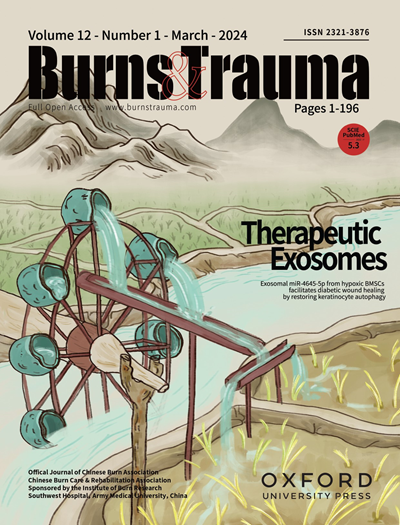miRNA鸡尾酒协调细胞反应,促进糖尿病伤口愈合
IF 9.6
1区 医学
Q1 DERMATOLOGY
引用次数: 0
摘要
慢性伤口,特别是糖尿病性溃疡,由于其复杂的病理和治疗方法的有限可用性,在全球范围内造成了重大的健康和经济负担。多种microrna (mirna)在伤口愈合的生物过程中起着至关重要的调节作用。然而,单mirna疗法可能无法完全克服受损伤口修复的多方面障碍。发现更有效的伤口疗法的努力有增无减。方法在本研究中,我们开发了一种靶向伤口愈合多个关键阶段的microRNA鸡尾酒:炎症、再上皮化、肉芽组织形成和血管生成。这种治疗鸡尾酒包括锁定核酸(LNA)修饰的miR-19b-3p、miR-132-3p和miR-31-5p的模拟物,以及miR-92a-3p的抑制剂,通过体内jetpei作为载体递送,解决伤口修复机制的多面性。在小鼠急性和慢性创伤模型上系统评价了鸡尾酒的创面愈合效果。结果伤口局部应用miRNA鸡尾酒可显著促进野生型小鼠急性伤口愈合,优于单个miRNA的作用。此外,miRNA鸡尾酒通过协调伤口部位的细胞反应,显著降低炎症细胞因子表达和CD68+巨噬细胞迁移,同时促进再上皮化、血管生成和肉芽组织形成,从而加速糖尿病伤口愈合。值得注意的是,在损伤后第30天,鸡尾酒还促进了伤口区域的神经再生。结论我们的研究结果表明,这种miRNA混合物在恢复慢性伤口愈合过程中具有潜在的治疗价值。因此,有必要在对照临床试验中进行进一步的研究,以确认这种miRNA混合物在临床环境中的有效性和适用性。本文章由计算机程序翻译,如有差异,请以英文原文为准。
A miRNA cocktail orchestrates coordinated cellular responses to promote diabetic wound healing
Background Chronic wounds, particularly diabetic ulcers, impose significant health and economic burdens globally because of their complex pathology and the limited availability of therapeutic approaches. Multiple microRNAs (miRNAs) play crucial roles in regulating biological processes in wound healing. However, single-miRNA therapies may not fully overcome multifaceted barriers of impaired wound repair. Efforts to discover more effective wound therapies continue unabated. Methods In this study, we developed a microRNA cocktail that targets multiple critical phases of the wound healing: inflammation, re-epithelialization, granulation tissue formation and angiogenesis. This therapeutic cocktail includes locked nucleic acid (LNA)-modified mimics of miR-19b-3p, miR-132-3p, and miR-31-5p, along with an inhibitor of miR-92a-3p, which are delivered via in vivo-jetPEI as the carrier, addressing the multifaceted nature of wound repair mechanisms. The wound healing efficacy of the cocktail were systematically evaluated in mouse models of acute and chronic wounds. Results Local application of the miRNA cocktail to wounds markedly enhanced acute wound healing in wild-type mice, outperforming the effects of the individual miRNAs. Moreover, the miRNA cocktail accelerated diabetic wound healing by orchestrating coordinated cellular responses at the wound site and significantly decreasing inflammatory cytokine expression and CD68+ macrophage migration while promoting re-epithelialization, angiogenesis and granulation tissue formation. Notably, the cocktail also facilitated nerve regeneration in the wound area at day 30 post-injury. Conclusions Our findings suggest that this miRNA cocktail has potential therapeutic value for revitalizing the healing process in chronic wounds. Therefore, further investigations in controlled clinical trials are warranted to confirm the efficacy and applicability of this miRNA cocktail in a clinical setting.
求助全文
通过发布文献求助,成功后即可免费获取论文全文。
去求助
来源期刊

Burns & Trauma
医学-皮肤病学
CiteScore
8.40
自引率
9.40%
发文量
186
审稿时长
6 weeks
期刊介绍:
The first open access journal in the field of burns and trauma injury in the Asia-Pacific region, Burns & Trauma publishes the latest developments in basic, clinical and translational research in the field. With a special focus on prevention, clinical treatment and basic research, the journal welcomes submissions in various aspects of biomaterials, tissue engineering, stem cells, critical care, immunobiology, skin transplantation, and the prevention and regeneration of burns and trauma injuries. With an expert Editorial Board and a team of dedicated scientific editors, the journal enjoys a large readership and is supported by Southwest Hospital, which covers authors'' article processing charges.
 求助内容:
求助内容: 应助结果提醒方式:
应助结果提醒方式:


